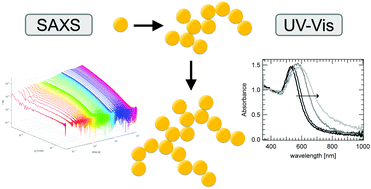Salt-induced cluster formation of gold nanoparticles followed by stopped-flow SAXS, DLS and extinction spectroscopy
Latest updated: May 29, 2020Authors: Nico Carl, Sylvain Prévost, Joseph P. S. Fitzgerald and Matthias Karg
Doi: 10.1039/C7CP01807J
Ref: Phys. Chem. Chem. Phys., 2017,19, 16348-16357
Abstract
In this work we investigate the salt-induced cluster formation of monodisperse, spherical gold nanoparticles possessing negative surface charge. Time dependent dynamic light scattering was used to determine the critical coagulation concentration and to study the kinetics of cluster growth. Cryo-TEM as well as small angle X-ray scattering allowed to obtain insights into the cluster morphology at various salt concentrations. The time dependent cluster growth was monitored by stopped-flow small angle X-ray scattering experiments and UV-Visible extinction measurements simultaneously. Our results reveal the transition from reaction limited cluster aggregation (RLCA) at low salt concentrations to diffusion limited cluster aggregation (DLCA) at high salt concentrations. We were able to correlate changes of the plasmon resonance position of the gold nanoparticles to the cluster size. By comparison to theoretical calculations using Mie theory, we found indication that stronger resonance shifts during cluster growth can be related to smaller inter-particle spacings.





